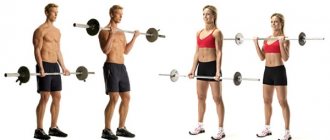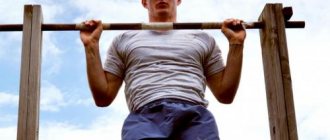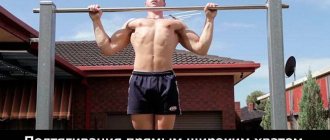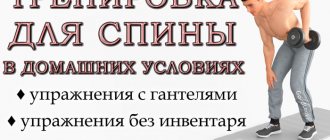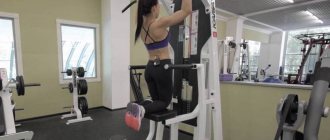Hello, lovers of sports and a healthy lifestyle. Do you want people turning around to admire you? Then read and take notes in your sports notebook. Everyone is familiar with the basic exercises for building muscle mass:
- Bench press.
- Squat with a barbell.
- Deadlift.
But there is one more thing for the back - these are pull-ups with weights on the bar. For results in gaining muscle mass, traditional pull-ups are not enough. The athlete’s muscles get used to it, thereby not receiving training stress and the impulse to grow in strength and volume. Additional weight will increase the load, which means it will force you to leave your “comfort zone”.
What kind of exercise is this?
In essence, these are the same hanging lifts, only with additional weight: with a chain or belt, to which plates from a barbell or dumbbells are tied.
When can you start lifting weights? For beginners, I recommend performing rows on the bar only after fully mastering the technique. The entrance test for admission is three approaches of 12 times. Each repetition is performed “cleanly”. Avoid jerking and swinging movements of the legs. If it comes easily to you, start exercising with weights.
Advantages and disadvantages
- Stretching has a positive effect on posture, helps build the entire array of back muscles and improves strength in basic exercises as a special preparatory movement.
- The movement is accessible to most people, progressing in strength is quite simple with it, you don’t need to use additional equipment, a horizontal bar and any weights are enough, you don’t even need exercise equipment
- However, there is also a negative point. Many people are genetically better suited to performing presses rather than rows, and for these, doing a pull-up can seem like a daunting task. It takes them quite a long time to perform movements with weights, and the work does not always give them pleasant moments.
- Many athletes complain that it is pull-ups that cause calluses, but they use other types of vertical rows in a fairly calm and safe manner. This is logical, since not all horizontal bars have a non-slip coating. It is worth using magnesium.
What muscles work?
When lifting the body to the crossbar, the following are used:
- Supraspinatus, infraspinatus, biceps and triceps brachii muscles.
- The levator scapulae muscle.
- Upper, lower parts of the trapezius muscle.
- Extensor carpi ulnaris and flexor carpi.
- The erector spinae muscle.
- Latissimus muscle.
Plus included in the work:
- Rectus abdominis muscle.
- Quadriceps and biceps femoris.
- Pectoralis major muscle.
Depending on the grip you choose, the load will vary.
Reverse and close grip - biceps and forearm.
A wide grip puts more stress on the latissimus muscles.
Developed abdominal muscles
It is impossible not to mention that even when performing classic pull-ups on a horizontal bar, the abdominal muscles are indirectly loaded. However, you can influence them directly:
One of the most effective exercises for this is leg raises. Take a comfortable grip on the bar and begin to slowly raise your legs until your fingertips touch the bar.
If this exercise seems very difficult for you, simply bend your knees and lift them until your knees touch your chest.
By the way, you can safely do the same exercises without leaving your apartment on our horizontal bars for your home.
Remember that these few minutes can extend your healthy life by several years :
The benefits and harms of pull-ups
Minimize the risk of harm to health by visiting a therapist first. If pathologies are detected, the doctor will develop a special program. Doctors do not always recommend hanging and doing pull-ups on an apparatus for people who have problems with the spine.
Positive sides:
- Correct posture.
- Prevention of spinal diseases.
- Muscle tone.
- Fast calorie burning.
Contraindications
The following health problems may interfere with exercise:
- Chronic diseases in acute form.
- Paralysis of arms and legs.
- Obesity.
- Heart failure.
- Poor blood flow to the brain.
- The presence of a hernia or protrusion.
Table of calorie consumption during physical activity
| Kind of activity | Kilocalorie consumption per hour | ||||
| per 1 kg of weight | for 50 kg weight | for 60 kg weight | for 70 kg weight | for 80 kg weight | |
| SPORTS | |||||
| SWIMMING AND WATER SPORTS | |||||
| Swimming (0.5 km/h) | |||||
| Slow breaststroke | |||||
| Swimming (2.5 km/h) | |||||
| Slow crawl swimming | |||||
| Swimming fast crawl | |||||
| Water aerobics | |||||
| Water skiing | |||||
| Water polo | |||||
| RIDING AND RIDING | |||||
| Cycling (9 km/h) | |||||
| Cycling (15 km/h) | |||||
| Cycling (20 km/h) | |||||
| Horse riding at trot | |||||
| Roller skating | |||||
| Skiing | |||||
| Skiing down the mountain | |||||
| Skating | |||||
| Ice-skating race | |||||
| Figure skating | |||||
| Rowing (4 km/h) | |||||
| Canoeing (4 km/h) | |||||
| CLASSES IN THE GYM | |||||
| Stretching | |||||
| Static yoga | |||||
| Ashtanga yoga | |||||
| Gymnastics (light) | |||||
| Medium intensity charging | |||||
| Gymnastics (vigorous) | |||||
| Aerobics classes | |||||
| Jumping rope | |||||
| Strength training on machines | |||||
| Elliptical training | |||||
| GAME SPORTS | |||||
| Hockey | |||||
| Field hockey | |||||
| Badminton (fast pace) | |||||
| Football | |||||
| Handball | |||||
| Basketball | |||||
| Volleyball | |||||
| Table tennis (doubles) | |||||
| Badminton (moderate pace) | |||||
| Tennis | |||||
| Struggle | |||||
| WALKING AND RUNNING | |||||
| Race walking | |||||
| Running (8 km/h) | |||||
| Running (16 km/h) | |||||
| Cross country running | |||||
| Running up and down the steps | |||||
| Running up the steps | |||||
| PHYSICAL ACTIVITY AND ENTERTAINMENT | |||||
| Ballet classes | |||||
| High intensity dancing | |||||
| Modern dancing | |||||
| Disco dancing | |||||
| Ballroom dancing | |||||
| Low intensity dancing | |||||
| Slow dancing (waltz, tango) | |||||
| Slow walking | |||||
| Hiking (4 km/h) | |||||
| Walking (at a speed of 5.8 km/h) | |||||
| Walking, 7.2 km/h | |||||
| Walking uphill (15% gradient, 3.8 km/h) | |||||
| Walking the dog | |||||
| Shopping | |||||
| Machine control | |||||
| Driving a scooter or motorcycle | |||||
| Fishing | |||||
| Diving | |||||
| Bowling | |||||
| Mountaineering | |||||
| CARE OF CHILDREN | |||||
| Playing with children while sitting | |||||
| Feeding and dressing the baby | |||||
| Bathing a child | |||||
| Carrying small children in your arms | |||||
| Playing with children with walking and running | |||||
| Playing with your child (moderate activity) | |||||
| Games with a child (high activity) | |||||
| Walking with a stroller | |||||
| Walking with children in the park | |||||
| HOMEWORK | |||||
| Window cleaning | |||||
| Cleaning glass and mirrors | |||||
| Cleaning carpets with a vacuum cleaner | |||||
| Dusting | |||||
| Cooking food | |||||
| Ironing clothes (standing) | |||||
| Washing dishes | |||||
| Easy cleaning | |||||
| Sweeping | |||||
| Plumbing cleaning | |||||
| PROFESSIONS AND OCCUPATIONS | |||||
| Singing | |||||
| Playing the guitar while standing | |||||
| Playing guitar while sitting | |||||
| Piano playing | |||||
| Wood sawyer job | |||||
| Bricklayer's work | |||||
| Wood chopping | |||||
| Work as a massage therapist | |||||
| Work of a carpenter or metal worker | |||||
| Shoemaker's work | |||||
| Bookbinder's work | |||||
| Hair Styling | |||||
| Hand sewing | |||||
| Knitting | |||||
| Reading aloud | |||||
| Working at the computer | |||||
| Fast typing on the keyboard | |||||
| Office work | |||||
| Classroom lesson, lesson | |||||
| Sex (active) | |||||
| Sitting at rest | |||||
| Eating while standing | |||||
| Personal hygiene | |||||
| Taking a shower | |||||
| Talking while eating | |||||
| Dressing and undressing, fitting | |||||
Previously, we already looked at how to learn how to do pull-ups on a horizontal bar from scratch. However, the topic of pull-ups on the horizontal bar is far from exhausted, because this type of sports activity is so multifaceted and useful that one article is clearly not enough.
And even if you don't consider yourself quite the sporty lady or gentleman, it's likely that you'll change the way you look at your crossbar prospects. Moreover, . And this is without exaggeration.
For women and men
Gone are the days when sports and fitness were clearly separated by gender. And if men are in no hurry to conquer the wisdom of Zumba and aerobics, then women boldly invade men’s territory.
The above fully applies to the addiction to horizontal bars and uneven bars.
One day I observed a curious picture. The clever girl “beat” the boys on the horizontal bar and uneven bars. The guys, with a concerned look, explained their loss by pain in their arm or fatigue after yesterday's training, to which the girl smiled indulgently and nodded her head in understanding.
Let me emphasize: the girl is slender, agile, physically developed, but does not look like a “jock.”
What am I getting at?
Pull-ups on the horizontal bar are equally useful for both women and men. And if everything is more or less clear with men, it will be interesting for women to know that they do not spoil feminine forms and do not make women masculine
(as, indeed, any type of fitness).
Women acquire disproportionate muscles only in two cases:
- problems with hormones;
- use of testosterone or anabolic steroids.
The natural amount of testosterone in women is 15 times lower than in men. Therefore, even if you do pull-ups on the horizontal bar and do push-ups for days on end, you won’t get hypertrophied muscles.
Techniques and types of pull-ups with weights
If you have learned the technique without weights, then there will be no difficulties. When working with cargo, consider the following nuances:
- Hang onto the horizontal bar from a stand without jumping.
- You can also go down through the stand.
- Eliminate rocking.
- Movements are smooth without jerking.
Use a vest as an additional load. The advantage over a weightlifting belt is that it does not put pressure on the spine.
- To ensure a secure grip, dry your hands with sports magnesium.
- Put on the weights and approach the horizontal bar so that it is above your head.
- Using a wall bars or stand, carefully perform the hang.
- As you exhale, bending your arms, smoothly rise to your chest.
- Pause briefly at the top, keeping your chin above the bar.
- As you inhale, controlling the fall of your body, lower yourself to a hanging position.
In order for your joints to get used to it, plan your first sessions using negative pulls.
- Stand on the bench so that your chin is above the bar.
- Bend your legs and lower yourself until your arms are almost bent at the elbows.
- Stand on the bench and take your starting position.
In addition to straight ones, when the crossbar touches the chest, pull-ups by the head are no less effective. I don't recommend it for beginners. Contraindicated for diseases of the cervical and shoulder girdle.
A beautiful wide back is the merit of the horizontal bar!
If you dream of becoming the owner of a wide, sculpted back, then the horizontal bar is what you need. It is difficult to imagine any other simulators and exercises that could just as effectively shape the back and upper torso as a whole.
You can do pull-ups using a variety of grips, but not all grips are equally beneficial for the back. To properly pump up your back, you need to pull yourself up with a wide grip and a little wider than average.
Grab the crossbar with your palms facing away from you (classic). When performing exercises, try to point your elbows to the sides, and not inward. Pull-ups with a wide head grip will be very effective.
You can read about which muscles are involved in such exercises in our article - “Exercises on the horizontal bar.”
Example workout
At home
The advantage of pull-ups is that you can do without a gym membership. Stretch your shoulders and hands. Jumping rope will perfectly warm up your whole body. A backpack with books works well as a weighting agent. Exercising with weights at home is not much different from training in the gym, which we will look at below.
In the gym
At the gym, warm up on the treadmill. Seven minutes of running will be enough to prepare the body for work. Do 2 - 3 pull-downs of the upper block to the chest for 6-8 repetitions. Choose a projectile weight of 60-70 percent of your own body weight. It is better to set aside a separate day to work out your back.
First training option
After the warm-up described above, with an additional weight of 8 kg, do 5 sets of 5 reps. Rest between sets for 90 seconds. In the next workout, increase the weight of the load so that you can complete the program 5 sets of 5 times.
Second training option
Take the test before you start. Do pull-ups without a vest as many times as possible. Let's say it will be 25 times. Wear a vest with 6 kg. Your task is to do 25 pull-ups with as few approaches as possible.
Next session, try to do 25 reps with the same weight for 4 sets, etc.
Third training option
“Ladder” is familiar from the schoolyard. Suitable for improving endurance. The exercise is performed according to the scheme 1-2-3-4-5-4-3-2-1. Rest time between approaches is no more than 15 seconds.
Inclusion in the program
- This is the main exercise for back training; it is better not to perform it on the same day as deadlifting. The athlete should divide his back training so that the deadlift is on a separate day and is accompanied by a heavy horizontal row, and the weighted pull-up is a separate exercise;
- The movement comes first in the plan; you first need to do several pull-ups without weights, and then gradually increase the weight to the working level. For most beginners, an adequate step will be 2.5 kg, for intermediate ones - 5 kg;
- The exercise is performed in 5-8 repetitions in 3-5 working approaches; you should not do extra approaches here, since the movement must be technically performed purely;
- On the day of “light” back training, you can alternate it with pull-ups for the number of times, or with vertical block rows;
- The load on the planes in the pull-up should be compensated by the standing press. The athlete performs it with at least half his own weight, trying to bring the tonnage in the standing press to approximately the numbers that are typical for pull-ups.
Tips for implementation
Sets and reps
To develop strength endurance, perform 20-25 repetitions with a weight of 50-60 percent of the maximum. Quickly rise to the bar and slowly descend to a hanging position.
Working for mass means performing with a weight of 70 - 80 percent of the maximum weight. You need to go up to the bar slowly and go down quickly.
Larger weights will help improve strength, 85 - 95 percent of the maximum weight for 2 - 4 repetitions. Rest for at least 3-4 minutes.
As you perform, concentrate on the tension in your back. Bring your shoulder blades together as much as possible and try to touch the horizontal bar with your chest. Record a video and analyze what technical mistakes you make.
What weight to choose
For the first week, limit your weight to 5 kg. As you progress through the programs listed in the “Training Examples” section, increase the weights by three kilograms. Focus on your own feelings to prevent overtraining.
Is it possible to do pull-ups every day?
Muscles in the human body are divided into three categories - large, medium and small. Each group needs different time for complete recovery, that is, rest and readiness for a new load. The large back muscles that are involved in pull-ups need 4-5 days to recover, the medium ones (deltoids) 3-4 days, and the small ones, such as the arm muscles, will need 1-2 days.
Consequently, the large muscles involved in pull-ups are unable to rest in one day and fully perform the exercise with renewed strength.
If you do pull-ups every day, such training will only lead to muscle fatigue, neither growth nor increase in strength. Tired muscles are unable to perform full loads, despite the athlete’s goals. This means that you won’t be able to increase the number of pull-ups or build sculpted muscles. If you do pull-ups even 10 times every day, even if the load is not maximum, the muscles will still experience fatigue and will not be able to recover properly, which means that the training will not provide any benefit. In addition, muscles that are tight and inflamed from daily stress will be most susceptible to injury - sprains, tears.
The benefits of horizontal bars for various diseases
The medical benefit of pull-ups on the horizontal bar is the prevention of scoliosis and osteochondrosis, since during exercise, blood vessels and capillaries are restored, which improve nutrition of the spine. A regular hang not only distributes intervertebral load evenly and quickly, but also regulates blood circulation in the body, stretches muscles after physical training and has a beneficial effect on the back in general. You will learn how to correct your posture using a horizontal bar in a separate article.
With pathologies in the intervertebral discs, cartilage tissue begins to wear out. The distance between the vertebrae decreases and the curvature of the spinal column changes, and the damaged areas bear a higher load. To combat the problem, you need to stretch your back: hanging on a horizontal bar brings undeniable benefits. This should be done every day for at least a minute in several approaches.
Many argue about the benefits and harms of the horizontal bar for intervertebral hernia. Doctors do not prohibit the exercise in the initial stages, since regular hanging helps to increase the intervertebral distance. However, exercises on the horizontal bar for a herniated spine should be performed after consultation with your doctor.
When lordosis and posture correction, you need to remember that the natural curve of the spine is changed and has a convexity, and deflections on the crossbar are prohibited. In this regard, the horizontal bar for training must be used so that the back does not bend - it is necessary to hang straight.
The benefits of horizontal bars for women
Now let’s figure out why the horizontal bar is useful for women. Exercises help you get beautiful posture, pump up your abs and lose weight. Regular pull-ups normalize posture and help relax the spine: it stretches and relieves tension that accumulates during sedentary work.
Exercises on the horizontal bar for girls are very useful. Leg raises to the chest or bar help build your abs and burn a lot of calories, helping you lose weight. The main thing is to create the right program and take care of the right diet.
